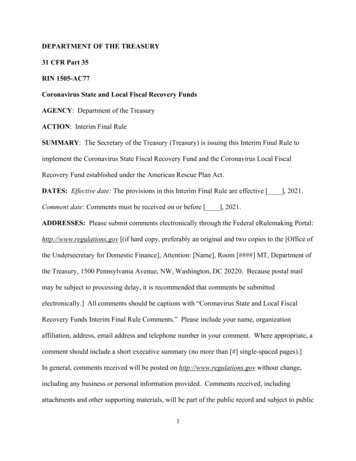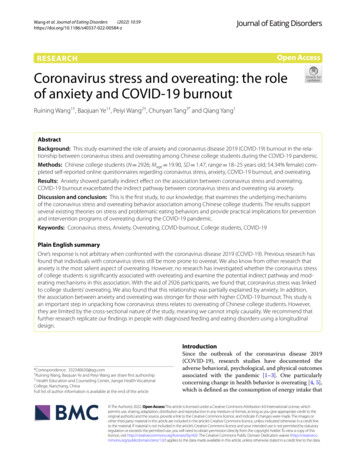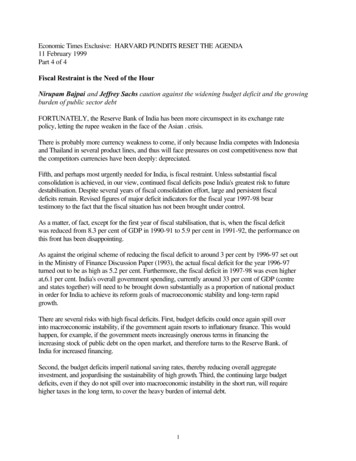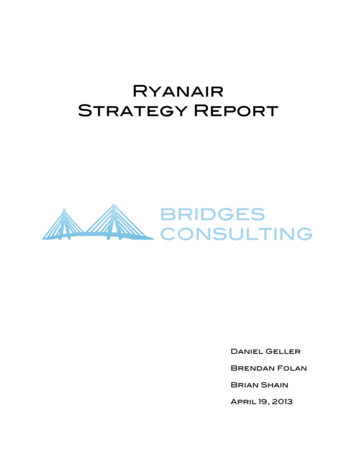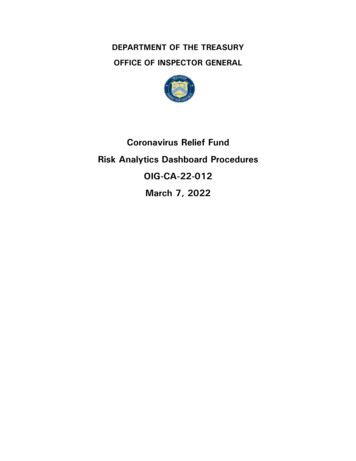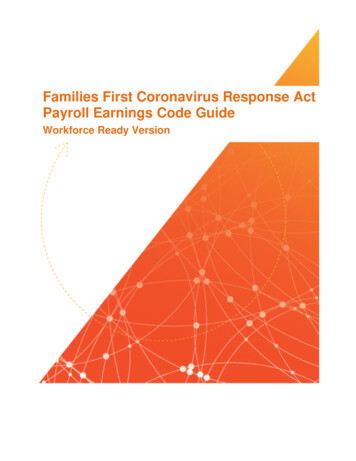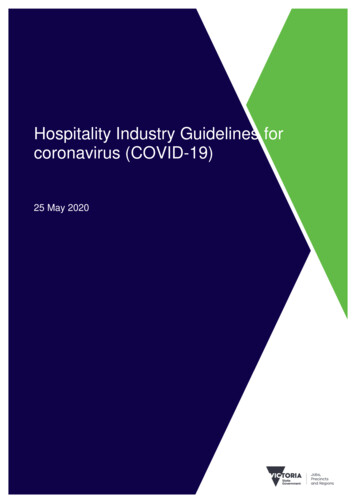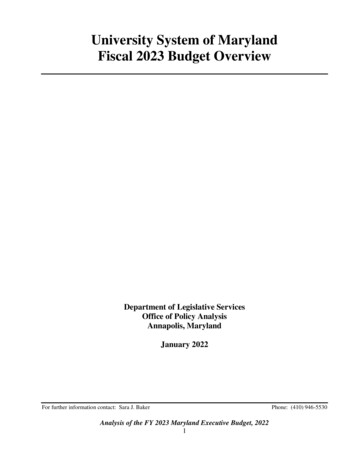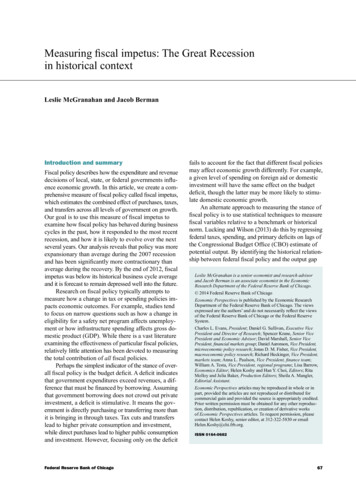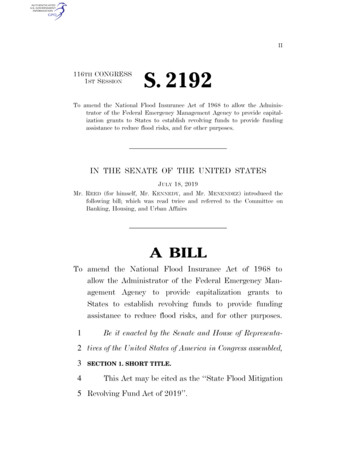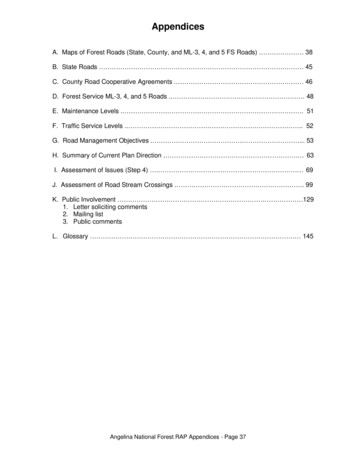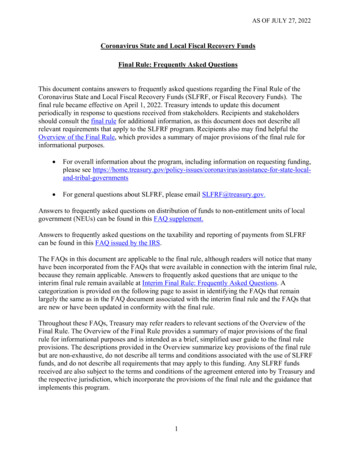
Transcription
AS OF JULY 27, 2022Coronavirus State and Local Fiscal Recovery FundsFinal Rule: Frequently Asked QuestionsThis document contains answers to frequently asked questions regarding the Final Rule of theCoronavirus State and Local Fiscal Recovery Funds (SLFRF, or Fiscal Recovery Funds). Thefinal rule became effective on April 1, 2022. Treasury intends to update this documentperiodically in response to questions received from stakeholders. Recipients and stakeholdersshould consult the final rule for additional information, as this document does not describe allrelevant requirements that apply to the SLFRF program. Recipients also may find helpful theOverview of the Final Rule, which provides a summary of major provisions of the final rule forinformational purposes. For overall information about the program, including information on requesting funding,please see s/assistance-for-state-localand-tribal-governments For general questions about SLFRF, please email SLFRF@treasury.gov.Answers to frequently asked questions on distribution of funds to non-entitlement units of localgovernment (NEUs) can be found in this FAQ supplement.Answers to frequently asked questions on the taxability and reporting of payments from SLFRFcan be found in this FAQ issued by the IRS.The FAQs in this document are applicable to the final rule, although readers will notice that manyhave been incorporated from the FAQs that were available in connection with the interim final rule,because they remain applicable. Answers to frequently asked questions that are unique to theinterim final rule remain available at Interim Final Rule: Frequently Asked Questions. Acategorization is provided on the following page to assist in identifying the FAQs that remainlargely the same as in the FAQ document associated with the interim final rule and the FAQs thatare new or have been updated in conformity with the final rule.Throughout these FAQs, Treasury may refer readers to relevant sections of the Overview of theFinal Rule. The Overview of the Final Rule provides a summary of major provisions of the finalrule for informational purposes and is intended as a brief, simplified user guide to the final ruleprovisions. The descriptions provided in the Overview summarize key provisions of the final rulebut are non-exhaustive, do not describe all terms and conditions associated with the use of SLFRFfunds, and do not describe all requirements that may apply to this funding. Any SLFRF fundsreceived are also subject to the terms and conditions of the agreement entered into by Treasury andthe respective jurisdiction, which incorporate the provisions of the final rule and the guidance thatimplements this program.1
AS OF JULY 27, 2022FAQ CategorizationVersionDateCategoryFAQ #1.0April 27, 2022#1.1 – #1.2, #1.4 – 1.7, #2.10, #2.12– #2.13, #3.8 – #3.13, #4.3, #4.5,#6.10 – #6.11, #6.14, #8.1, #8.3,#10.1 – #10.2, #11.1 – 11.3, #11.6 –11.12, #12.1 – 12.21.0April 27, 2022FAQs retained withslight modificationsfrom the Interim FinalRule: FrequentlyAsked Questionsdocument (please notethat FAQ numberinghas changed betweenthe two documents)New or SubstantiallyUpdated FAQs2.0July 27, 2022Updated FAQs#1.3, #1.8, #2.1 – #2.9, #2.11, #2.14– #2.24, #3.1 – 3.7, #3.14, #4.1 –#4.2, #4.4, #4.6, #4.7 – #4.10, #5.1 –#5.4, #6.1 – #6.9, #6.12 – #6.13,#6.15 – #6.16, #8.2, #11.4 – #11.5,Section 13#2.14, #3.1, #4.92.0July 27, 2022New FAQs#6.17 - #6.20, #13.13 - #13.172
1. Eligibility and Allocations1.1. Which governments are eligible for funds?The following governments are eligible: States and the District of ColumbiaTerritoriesTribal governmentsCountiesMetropolitan citiesNon-entitlement units, or smaller local governments1.2. Which governments receive funds directly from Treasury?Treasury distributes funds directly to each eligible state, territory, metropolitan city,county, or Tribal government. Smaller local governments that are classified as nonentitlement units receive funds through their applicable state government.1.3. Are special-purpose units of government eligible to receive funds?Special-purpose units of local government are not eligible to receive an award as arecipient under the SLFRF program; however, a state, territory, local, or Tribalgovernment may transfer funds to a special-purpose unit of government to carry out aprogram or project on its behalf as a subrecipient. Special-purpose districts performspecific functions in the community, such as fire, water, sewer or mosquito abatementdistricts. A recipient can also provide funds to an entity that is special-purpose governmentfor the purpose of directly benefitting the entity as a result of the entity experiencing apublic health impact or negative economic impact of the pandemic.1.4. How are funds being allocated to Tribal governments, and how will Tribalgovernments find out their allocation amounts? 20 billion of Fiscal Recovery Funds was reserved for Tribal governments. The AmericanRescue Plan Act specified that 1 billion would be allocated evenly to all eligible Tribalgovernments. The remaining 19 billion was to be distributed using an allocationmethodology determined by Treasury, which was based on enrollment and employment.There were two payments to Tribal governments. Each Tribal government’s first paymentincluded (i) an amount in respect of the 1 billion allocation that was to be divided equallyamong eligible Tribal governments and (ii) each Tribal government’s pro rata share of theEnrollment Allocation. Tribal governments were notified of their allocation amount anddelivery of payment 4-5 days after completing request for funds in the TreasurySubmission Portal. The deadline to make the initial request for funds was June 21, 2021.3
The second payment included a Tribal government’s pro rata share of the EmploymentAllocation. There was a 1,000,000 minimum employment allocation for Tribalgovernments. In late June 2021, Tribal governments received an email notification to reenter the Treasury Submission Portal to confirm or amend their 2019 employment numbersthat were submitted to Treasury for the CARES Act’s Coronavirus Relief Fund. To receivean Employment Allocation, including the minimum employment allocation, Tribalgovernments must have confirmed employment numbers by July 23, 2021. Treasurycalculated employment allocations for those Tribal governments that confirmed orsubmitted amended employment numbers by the deadline. In August, Treasurycommunicated to Tribal governments the amount of their portion of the EmploymentAllocation and the anticipated date for the second payment.1.5. My county is a unit of general local government with population under 50,000.Will my county receive funds directly from Treasury?Yes. All counties that are units of general local government receive funds directly fromTreasury and should apply via the online portal. The list of county allocations is availablehere.1.6. My local government expected to be classified as a non-entitlement unit. Instead,it was classified as a metropolitan city. Why?The American Rescue Plan Act (ARPA) defines, for purposes of the Coronavirus LocalFiscal Recovery Fund (CLFRF), metropolitan cities to include those that are currentlymetropolitan cities under the Community Development Block Grant (CDBG) program butalso those cities that relinquish or defer their status as a metropolitan city for purposes ofthe CDBG program. This would include, by way of example, cities that are principal citiesof their metropolitan statistical area, even if their population is less than 50,000. In otherwords, a city that is eligible to be a metropolitan city under the CDBG program is eligibleas a metropolitan city under the CLFRF, regardless of how that city has elected toparticipate in the CDBG program.Unofficial allocation estimates produced by other organizations may have classified certainlocal governments as non-entitlement units of local government. However, based on thestatutory definitions, some of these local governments should have been classified asmetropolitan cities.1.7. In order to receive and use funds, must a recipient government maintain adeclaration of emergency relating to COVID-19?No. Neither the statute establishing the SLFRF nor the final rule requires recipients tomaintain a local declaration of emergency relating to COVID-19.1.8. Can nonprofit or private organizations receive funds? If so, how?Yes. Under section 602(c)(3) of the Social Security Act, a State, territory, or Tribal4
government may transfer funds to a “private nonprofit organization . . . , a Tribalorganization . . . , a public benefit corporation involved in the transportation of passengersor cargo, or a special-purpose unit of State or local government.” Similarly, section603(c)(3) authorizes a local government to transfer funds to the same entities (other thanTribal organizations). The interim final rule clarified that the lists of transferees in sections602(c)(3) and 603(c)(3) are not exclusive, and the final rule clarified that recipients maytransfer funds to any entity to carry out, as a subrecipient, an eligible activity on behalf ofthe SLFRF recipient (transferor), as long as they comply with the SLFRF Award Termsand Conditions and other applicable requirements. A transferee receiving a transfer from arecipient under sections 602(c)(3) and 603(c)(3) will be considered a subrecipient and willbe expected to comply with all subrecipient reporting requirements.Additionally, a recipient can provide funds to an entity, including a nonprofit organization,for the purpose of directly benefitting the entity as a result of the entity experiencing apublic health impact or negative economic impact of the pandemic. In this instance, theseentities will be considered beneficiaries, not subrecipients, and will not be expected tocomply with subrecipient reporting requirements. Beneficiary reporting requirements willapply.The ARPA does not authorize Treasury to provide SLFRF funds directly to nonprofit orprivate organizations. Thus, a nonprofit or private organization should seek funds fromSLFRF recipient(s) in their jurisdiction (e.g., a State, local, territorial, or Tribalgovernment).2. Eligible Uses – Responding to the Public Health Emergency /Negative Economic Impacts2.1. If a use of funds is not explicitly permitted in the final rule as a response to thepublic health emergency and its negative economic impacts, does that mean it isprohibited?No. The final rule provides a non-exhaustive list of enumerated uses that respond topandemic impacts. The final rule also presumes that some populations experiencedpandemic impacts and are eligible for responsive services. Recipients also have broadflexibility to (1) identify and respond to other pandemic impacts and (2) serve otherpopulations that experienced pandemic impacts, beyond the enumerated uses andpresumed eligible populations. Recipients can also identify groups or “classes” ofbeneficiaries that experienced pandemic impacts and provide services to those classes.2.2. What types of services are eligible as responses to the negative economicimpacts of the pandemic?Eligible uses to respond to the negative economic impacts of the pandemic includeassistance to households and communities; assistance to small businesses and nonprofits;aid to impacted industries; and uses to support public sector capacity and workforce. For5
an overview of the eligible uses within each of these subcategories, please see pages 1213 and 16-34 of the Overview of the Final Rule. The eligible uses within this categoryinclude programs and services to respond to impacts of the pandemic on households andcommunities, such as: Cash assistance Food assistance (e.g., child nutrition programs, including school meals) & foodbanks Childcare and early learning services, home visiting programs, services for childwelfare-involved families and foster youth & childcare facilities Programs or services to support long-term housing security, includingdevelopment of affordable housing and permanent supportive housingThey also include uses to bolster public sector capacity and workforce, such as: Payroll and covered benefits for public safety, public health, health care, humanservices and similar employees of a recipient government, for the portion of theemployee’s time spent responding to COVID-19. Payroll and covered benefits for additional public sector workers up to a prepandemic baseline that is adjusted for historic underinvestment in the publicsector, providing additional funds for employees who experienced pay cuts orwere furloughed, avoiding layoffs, providing worker retention incentives, andpaying for ancillary administrative costs related to hiring, support, and retention.These tools can allow recipients not only to bring back laid-off workers, but to addresscritical shortages of teachers, instructional aides, transportation workers, behavioralhealth workers, and other key government personnel, by funding positions at competitivewages and improving job quality in these sectors (see FAQs #2.15, #2.16, #2.17).Recipients also have broad flexibility to identify and respond to other pandemic impactsand serve other populations that experienced pandemic impacts, beyond the enumerateduses. For more information on identifying eligible uses beyond those enumerated, pleasesee pages 32-34 of the Overview of the Final Rule.2.3. What types of COVID-19 response, mitigation, and prevention activitiesare eligible?Please see pages 12-14 of the Overview of the Final Rule for a non-exhaustive list ofenumerated eligible uses relating to COVID-19 mitigation and prevention, as well asinformation about how to design other responses that are not included in the list.6
2.4. May recipients use funds to respond to the public health emergency and itsnegative economic impacts by providing direct cash transfers to households?Yes. Cash transfers, like all eligible uses in the public health and negative economicimpacts category, must respond to the negative economic impacts of the pandemic on ahousehold or class of households. Recipients may presume that low- and moderateincome households (as defined in the final rule), as well as households that experiencedunemployment, food insecurity, or housing insecurity, experienced a negative economicimpact due to the pandemic. Recipients may also identify other households or classes ofhouseholds that experienced a negative economic impact of the pandemic and providecash assistance that is reasonably proportional to, and not grossly in excess of, theamount needed to address the negative economic impact. For example, in the ARPA,Congress authorized Economic Impact Payments to households at certain income levels,identifying and responding to a negative economic impact of the pandemic on thesehouseholds.Treasury has reiterated in the final rule that responses to negative economic impactsshould be reasonably proportional to the impact that they are intended to address. Usesthat bear no relation or are grossly disproportionate to the type or extent of harmexperienced would not be eligible uses. Reasonably proportional refers to the scale of theresponse compared to the scale of the harm. It also refers to the targeting of the responseto beneficiaries compared to the amount of harm they experienced; for example, it maynot be reasonably proportional for a cash assistance program to provide assistance in avery small amount to a group that experienced severe harm and in a much larger amountto a group that experienced relatively little harm. Please also see questions 7-10 from theIRS-issued FAQ on SLFRF relating to the taxability of cash transfers.2.5. May recipients use funds to respond to the public health emergency and itsnegative economic impacts by replenishing unemployment funds?Recipients may only use SLFRF funds for contributions to unemployment insurancetrust funds and repayment of the principal amount due on advances received under TitleXII of the Social Security Act up to an amount equal to (i) the difference between thebalance in the recipient’s unemployment insurance trust fund as of January 27, 2020 andthe balance of such account as of May 17, 2021, plus (ii) the principal amountoutstanding as of May 17, 2021 on any advances received under Title XII of the SocialSecurity Act between January 27, 2020 and May 17, 2021. Further, recipients may useSLFRF funds for the payment of any interest due on such Title XII advances.Additionally, a recipient that deposits SLFRF funds into its unemployment insurancetrust fund to fully restore the pre-pandemic balance may not draw down that balance anddeposit more SLFRF funds, back up to the pre-pandemic balance. Through December31, 2024, recipients that deposit SLFRF funds into an unemployment insurance trustfund, or use SLFRF funds to repay principal on Title XII advances, may not take actionto reduce benefits available to unemployed workers by changing the computationmethod governing regular unemployment compensation in a way that results in areduction of average weekly benefit amounts or the number of weeks of benefits7
payable (i.e., maximum benefit entitlement).2.6. May funds be used to reimburse recipients for costs incurred by state, localand Tribal governments in responding to the public health emergency and itsnegative economic impacts prior to passage of the American Rescue Plan?Use of SLFRF is generally forward looking. The final rule permits funds to be used tocover costs incurred beginning on March 3, 2021.2.7. May recipients use funds for general economic development?Generally, no. General economic development – activities that do not respond to negativeeconomic impacts of the pandemic but rather seek to more generally enhance thejurisdiction’s business climate – would generally not be eligible under this eligible usecategory.To identify an eligible use of funds under the public health and negative economicimpacts category, a recipient must identify a beneficiary or class of beneficiaries thatexperienced a harm or impact due to the pandemic, and eligible uses of funds must bereasonably designed to respond to the harm, benefit the beneficiaries that experienced it,and be related and reasonably proportional to that harm or impact. For example, jobtraining and other supports – like childcare, transportation, and subsidized employment –for unemployed workers may be used to address negative economic impacts of the publichealth emergency and be eligible.2.8. How can recipients use funds to assist the travel, tourism, and hospitalityindustries? May recipients use funds to assist impacted industries other thantravel, tourism, and hospitality?Please see pages 24-25 of the Overview of the Final Rule.2.9. How does the final rule help address the disparate impact of COVID-19 oncertain populations and geographies?In recognition of the long-standing disparities in health and economic outcomes inunderserved communities that have amplified and exacerbated the impacts of thepandemic, the final rule identifies certain populations as “disproportionately impacted” bythe pandemic and enumerates a broad range of services and programs to address healthdisparities, to build stronger communities through investments in neighborhoods, toaddress educational disparities, to provide rental assistance vouchers or assistancerelocating to areas of greater economic opportunity, and other eligible uses to respond tonegative economic impacts in disproportionately impacted communities.Specifically, Treasury will presume that certain populations were disproportionatelyimpacted by the pandemic and therefore automatically eligible to receive responsiveservices. See page 19 of the Overview of the Final Rule for a full list of the8
populations presumed disproportionately impacted by the pandemic.Recipients may also provide responsive services to other populations, households,or geographic areas disproportionately impacted by the pandemic. In identifyingthese disproportionately impacted communities, recipients should be able to supporttheir determination for how the pandemic disproportionately impacted thepopulations, households, or geographic areas to be served.Treasury has provided a non-exhaustive list of eligible responses to servedisproportionately impacted communities on page 20 of the Overview of the FinalRule. Note that these are an enhanced set of responses available in addition toresponses available to respond to impacts of the pandemic on households andcommunities (including those listed on page 18 of the Overview).2.10. May recipients use funds to pay for vaccine incentive programs (e.g., cash orin-kind transfers, lottery programs, or other incentives for individuals who getvaccinated)?Yes. Under the final rule, recipients may use SLFRF funds to respond to the COVID-19public health emergency, including expenses related to COVID-19 vaccinationprograms.Programs that provide incentives reasonably expected to increase the number of peoplewho choose to get vaccinated, or that motivate people to get vaccinated sooner than theyotherwise would have, are an allowable use of funds so long as such costs are reasonablyproportional to the expected public health benefit.2.11. How can recipients use funds to support workers returning to work?Under the final rule, recipients may use SLFRF funds under the public health andnegative economic impacts eligible use category to provide assistance to individuals whowant and are available for work, including job training, public jobs programs and fairs,support for childcare and transportation to and from a jobsite or interview, cash andother incentives for newly employed workers, subsidized employment, grants to hireunderserved workers, assistance to unemployed individuals to start small businesses, anddevelopment of job and workforce training centers.2.12. What staff are included in “public safety, public health, health care, humanservices, and similar employees”? Would this include, for example, 911 operators,morgue staff, medical examiner staff, or EMS staff?As discussed in the final rule, funds may be used for payroll and covered benefitsexpenses for public safety, public health, health care, human services, and similaremployees, for the portion of the employee’s time that is dedicated to responding to theCOVID-19 public health emergency.Public safety employees would include police officers (including state police officers),9
sheriffs and deputy sheriffs, firefighters, emergency medical responders, correctional anddetention officers, and those who directly support such employees such as dispatchersand supervisory personnel. Public health employees would include employees involved inproviding medical and other health services to patients and supervisory personnel,including medical staff assigned to schools, prisons, and other such institutions, and othersupport services essential for patient care (e.g., laboratory technicians, medical examineror morgue staff) as well as employees of public health departments directly engaged inmatters related to public health and related supervisory personnel. Note that this categoryencompasses both public health and health care employees; both are treated as publichealth employees for the purposes of this eligible use category. Human services staffinclude employees providing or administering social services; public benefits; childwelfare services; and child, elder, or family care, as well as others.2.13. May recipients use funds to establish a public jobs program?Yes. Under the public health and negative economic impacts eligible use category, thefinal rule permits a broad range of services to unemployed or underemployed workers andother individuals that suffered negative economic impacts from the pandemic. That caninclude public jobs programs, subsidized employment, combined education and on-thejob training programs, or job training to accelerate rehiring or address negative economicor public health impacts experienced due to a worker’s occupation or level of training.The broad range of permitted services can also include other employment supports, suchas childcare assistance or assistance with transportation to and from a jobsite or interview.2.14. Can funds be used for investments in affordable housing?Yes. Under the final rule, “Development, repair, and operation of affordable housing andservices or programs to increase long-term housing security” is an enumerated eligible useto respond to impacts of the pandemic on households and communities. Treasury continuesto strongly encourage the use of SLFRF for affordable housing and has updated this FAQto promote clarity and administrability in the use of these funds.Affordable housing projects must be responsive and proportional to the harm identified.This standard may be met by affordable housing development projects—which mayinvolve large expenditures and capital investments—if the developments increase thesupply of long-term affordable housing for households that experienced associatedpandemic impacts under the final rule.Presumptively Eligible UsesFor purposes of this standard, if a project fits within either of the below presumptions,Treasury will presume that a project is eligible. As discussed more below, Treasury willpresume that the following affordable housing investments are eligible uses of SLFRFfunds as responses to the negative economic impacts of the pandemic: (1) projects thatwould be eligible for funding under an expanded list of federal housing programs and (2)projects for the development, repair, or operation of affordable rental housing with certainincome and affordability requirements. Recipients’ affordable housing projects may use10
either of these presumptions to qualify as a presumptively eligible use. If a recipient usesone presumption for an affordable housing project, the recipient may still use a differentpresumption for another affordable housing project.Presumption 1: Treasury will presume that any project that is eligible to be funded underany of the following federal housing programs is an eligible use of SLFRF funds as aresponse to the negative economic impacts of the pandemic: The National Housing Trust Fund (HTF, administered by HUD);The Home Investment Partnerships Program (HOME, administered by HUD);The Low-Income Housing Tax Credit (administered by Treasury);The Public Housing Capital Fund (administered by HUD);Section 202 Supportive Housing for the Elderly Program and Section 811Supportive Housing for Persons with Disabilities Program (administered byHUD);Project-Based Rental Assistance (PBRA) (administered by HUD); andMultifamily Preservation & Revitalization program (administered by USDA).In previous guidance, presumptive eligibility for affordable housing projects was limited toHOME and HTF. Treasury has updated this list by adding additional programs in an effortto increase administrability and clarity in the use of SLFRF funds for affordable housingpurposes. This update is also expected to decrease the transaction costs associated withlayering SLFRF funds with existing projects. Note that these programs use differentincome limits than the definitions of low- and moderate-income adopted by Treasury.Given the severity of the affordable housing shortage, and the ways in which the pandemichas exacerbated the need for affordable, high-quality dwelling units, Treasury hasdetermined that the households served by these federal housing programs have beenimpacted by the pandemic and its negative economic impacts and that development ofaffordable housing consistent with these programs is a related and reasonably proportionalresponse to those impacts. Additionally, affordable housing projects provided by a Tribalgovernment are eligible uses of SLFRF funds if they would be eligible for funding underthe Indian Housing Block Grant program, the Indian Community Development BlockGrant program, or the Bureau of Indian Affairs Housing Improvement Program.To the extent that a recipient chooses to use SLFRF funds to invest in affordable housingprojects in alignment with these federal housing programs, the investment agreement mustrequire the covered project or units to adhere to all applicable local codes, and comply, at aminimum, with the applicable federal housing program’s requirements related to: Resident income restrictions;The period of affordability and related covenant requirements for assisted units;Tenant protections; andHousing quality standards.Presumption 2: Treasury will presume that an investment in the development, repair, or11
operation of any affordable rental housing unit is an eligible use of SLFRF funds torespond to the negative economic impacts of the pandemic if the unit has a limitedmaximum income of 65% area median income (AMI), as imposed through a covenant,land use restriction agreement, or other enforceable legal requirement for a period of atleast 20 years. A jurisdiction may establish a longer period of affordability at itsdiscretion. This presumption is available even if the project does not align with the federalhousing programs specified in Presumption 1.Under this presumption, recipients may use SLFRF funds as part of the financing for amixed-income housing project if the total financing made up of SLFRF funds does notexceed the total development costs attributable to affordable housing units limited tohouseholds at or below 65% AMI for the affordability period. For example, if 25% of aproject’s units are reserved for families at or below 65% AMI for the affordability period,and 20% of the total development costs of the project are attributable to such reservedunits, then SLFRF funds may be used to pay for up to 20% of the total development costs.The income limit and 20-year affordability covenant does not need to apply to specificunits, but rather it may specify a number of units within the developmen
FAQ issued by the IRS. The FAQs in this document are applicable to the final rule, although readers will notice that many have been incorporated from the FAQs that were available in connection with the interim final rule, because they remain applicable. Answers to frequently asked questions that are unique to the
